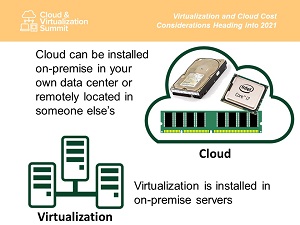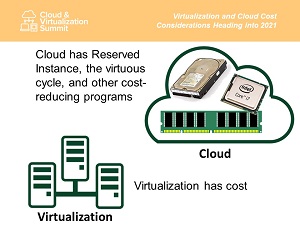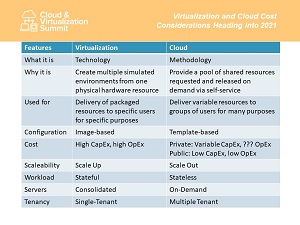News
Cloud vs. Virtualization: What's the Difference?
A recent online tech event about cost considerations for virtualization and cloud computing started out with the basics by explaining exactly what the difference is between the two, especially pertinent to readers of this publication that happens to be named Virtualization & Cloud Review.
"If you think of cloud computing and virtualization you say, well, what's the difference? They're interchangeable. You're not alone. I mean, a lot of people feel exactly the same way. You aren't correct, but you're not alone," began Howard M. Cohen, a 35-year IT channel executive, industry writer and frequent presenter, in leading off the recent "Virtualization and Cloud Cost Considerations Heading into 2021" event. Cohen is also a Sr. Resultant at The TechChannel Partners' Results Group.
"And so we're going to try and pull apart the two from each other today," he continued. "And by the way, when I say you're not alone, it was a Forrester Research report that found that 70 percent of what IT administrators call private clouds don't actually fit the description of cloud computing. But that's okay. You say 'tomayto,' I say 'tomahto,' they say virtualized cloud."
In pulling apart the two, here's how Cohen listed these characteristics:
-
Basic Description
 [Click on image for larger view.]
[Click on image for larger view.]
Cloud provides a pool of shareable resources that can be rapidly provisioned, used, scaled, and released via self-service: "The definition of cloud is that it provides a pool, a pool of resources that can be shared amongst many different users. They're rapidly provisioned -- you just ask for them. It's not like you have to go spin up another machine and put a server in it and all kinds of guys. You know, you don't, you just simply say 'I want more,' and you get more, -- not like going to dinner.
"The thing is, you've got to make sure when you're done using it, that you release it. Otherwise you keep paying for it. Because cloud uses consumption-based billing. That means you pay for what you use. And so when you request something, you start paying for it. When you release it, you stop paying for it. If you don't release it, you're running some risk."
Virtualization makes one resource act like many: "Virtualization basically allows you to run dozens, in some cases, hundreds of servers on one box. It seems like you have dozens, but there's only one box. That means one box to manage. It means one box to power, one box to cool. There's a lot of good reasons why we want to do that. So that's virtualization: putting many server virtual machines into one real machine."
-
Installation
 [Click on image for larger view.]
[Click on image for larger view.]
Cloud can be installed on-premise in your own data center or remotely located in someone else's: "Cloud can be installed on-premises in your own datacenter, but it can also be installed at somebody else's datacenter. It can be installed remotely. Cloud is not a reference to where it is. Cloud is a reference as to how it's built.
"Cloud, in an example of another comparison, cloud has reserved instances, which is a billing construct. You can reserve virtual machines, virtual servers in advance, that you can simply summon up when you need them. And by ordering and making commitment to more of them, you get a better price. One good way of bringing your costs down."
Virtualization is installed in on-premises servers: "When you are virtualizing a server, you're basically running that in your own server on your own premises. Your server in your building. You go in, you run virtualization on it, and you establish as many sessions as you want to or can on that machine."
-
Costs
 [Click on image for larger view.]
[Click on image for larger view.]
Cloud has reserved instances, the virtuous cycle, and other cost-reducing programs: "Cloud has reserved instances, which is a billing construct. You can reserve virtual machines, virtual servers, in advance, that you can simply summon up when you need them. And by ordering and making commitment to more of them, you get a better price. One good way of bringing your costs down.
"There's also the virtuous cycle, which is not really a pricing program. It basically describes the concept that as a cloud provider gets better, they add more customers, more people, more subscribers using their cloud service. They have to add more equipment, and then they get more customers. And as that keeps on getting larger, more customers, more equipment and more customers, that's a virtuous cycle. It keeps getting bigger and bigger and they can bring their prices down. Thanks to economies of scale. So the virtuous cycle benefits you the subscriber, a great deal.
"And people say that one particular cloud provider is the king of the virtuous cycle. That's slowly but surely becoming no longer the case. Many cloud providers now have a virtuous cycle going on. And the good news is, our prices are coming down. So there are great cost-cutting programs, cost-reducing programs, available."
Virtualization has cost: "It's just that Simple. It's not like you're paying for an ongoing service. You're installing a capability into your own servers, therefore, you've paid for the software, you've paid for the hardware, you're paying to power that hardware to cool that hardware to maintain that hardware. You're paying and you're paying and you're paying. So it's a costly consideration.
"Now, in all fairness, you can bring those costs down. And the ways in which you can bring those costs down include effective management. There are many different platform products that will enable you to manage your virtual machines amongst your physical servers. For example, you can move a virtual machine from one machine to another, if the machine is on and it's getting overloaded. And as a matter of fact, if you end up removing all of the virtual machines from a physical server, it will automatically shut that server down, saving you power.
"So there's a lot of automation available to you to effectively manage your server farm when you have many physical servers running a multiple of virtual machines. And that's a good way to bring your costs down, important to be aware of."
To sum up the cloud vs. virtualization comparison, Cohen provided this graphic:
 [Click on image for larger view.]
[Click on image for larger view.]
Cohen went on to discuss monitoring, migration, desktop virtualization, more in-depth cost comparisons and much more.
Implications for 2021
He also looked at the implications for 2021, as we're in the midst of the COVID-19 pandemic that sees people working from home and possibly unstaffed datacenters.
"There are some things we need to consider. For example, what is your office going to look like? Well, if you're like a lot of other people, this is what your office looks like now [picture of a home]. But how much longer will it look like that? How much longer will this continue, your house continue to be your office? The fact of the matter is that working from home is upon us. Okay, we're probably using VDI [Virtual Desktop Infrastructure], maybe we're using [desktop-as-a-service].
"If we're using VDI, and we're connecting to our own company's datacenter, who's there? Who's at the datacenter? You're home because you're afraid of getting sick -- so are datacenter operators. So there aren't people living and working necessarily in your corporate datacenter. So the question becomes, how do you manage a deserted datacenter? And what are the costs?
"I mean, it's going to be more expensive. And matter of fact, the cost could include human lives. So it's a scary concept. And what we need to think about is okay, let's answer the question: How do we manage this deserted datacenter? And the answer, of course, is remotely. So we need to start thinking about, How do I establish something that will tell me when something needs my attention? And the answer, of course, is monitoring."
To learn more about Cohen's thoughts on monitoring, see this article that was also based on his presentation: Cloud Computing Costs Tip: 'Whatever You Spend on Monitoring Is Worth It'.
Cohen's presentation on cloud computing costs was one segment of a three-part online summit hosted by Virtualization & Cloud Review on Aug. 28. You can freely view the presentation by going here.
You can also see upcoming free online events presented by Virtualization & Cloud Review by going here.
About the Author
David Ramel is an editor and writer at Converge 360.